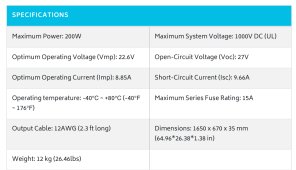I want to have either 6 or 8 panels, 200 watt
I have 6, 12 volt Lithium 100ah renogy
How should I configure them? Considering charge controllers which I can pick after.
8 panels @ 200 w...1600w /12v = 133.33 amp
6 panels @ 200 w...1200 / 12v = 100 amp
With a large controller
Should I....
Run 2 groups of panels and banks, with two charge controllers? Or keep one large one?
Is there better way? I can’t run them at 24v.
Open to suggestion, I also still have the choice of controllers and panels...I only have the batteries
I have 6, 12 volt Lithium 100ah renogy
How should I configure them? Considering charge controllers which I can pick after.
8 panels @ 200 w...1600w /12v = 133.33 amp
6 panels @ 200 w...1200 / 12v = 100 amp
With a large controller
Should I....
Run 2 groups of panels and banks, with two charge controllers? Or keep one large one?
Is there better way? I can’t run them at 24v.
Open to suggestion, I also still have the choice of controllers and panels...I only have the batteries



